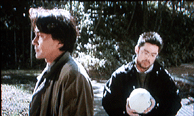An unassuming man in a plaid sport coat walks with a confident gait through the streets and removes a section of pipe from an exposed water line in a tunnel. The scene cuts to a shot of the same man calmly pacing the floor of an anonymous hotel room with a drink in hand before inexplicably bludgeoning his companion, then subsequently bathing, his clothes neatly folded and arranged on the sink cabinet. Police inspector Takabe (Koji Yakusho) investigates the grisly crime scene and notes that the carotid arteries of the victim were neatly severed, forming an ‘X’ mark on the woman’s neck. However, the disquieting precision of the seemingly calculated murder is negated by the killer’s apparent clumsiness in leaving identifiable personal items in the room, and he is immediately apprehended. Meanwhile, on the idyllic coastline of Shirasato, an enigmatic drifter (Masato Hagiwara) approaches a teacher named Hanaoka studying on the beach and casually asks where he is. Moments later, the disoriented young man returns and repeats his question, before explaining his amnesiac condition and asking for help. The well-intentioned Hanaoka brings the drifter home in an attempt to aid the young man in determining his identity. The young man’s overcoat indicates that his name is Mamiya, but his memory proves to be impenetrable, and is unable to confirm the information. Instead, Mamiya spends an uneventful evening repeatedly asking Hanaoka the same seemingly innocuous questions. The following day, Hanaoka’s wife, Tomoko, is found dead with the familiar signature ‘X’ on her neck, and the distraught and guilt-ridden teacher attempts suicide by crashing through the window of their home. But is there a common element to the seemingly random, yet intrinsically connected murders beyond each atypical killer’s inexplicably fatal compulsion?
Cure is an understatedly haunting, metaphoric, and deeply disturbing exploration of identity, alienation, and moral conscience. From the opening shot of Fumie Takabe’s (Anna Nakagawa) dispassionate reading of Bluebeard to a distracted (and physically removed) psychiatrist in an austere and a sparsely furnished office (note the distance of the psychiatrist’s chairs during the analysis), Kiyoshi Kurosawa establishes a pervasive sense of profound detachment through empty spaces, oppressive industrial landscapes, and isolated framing: the sudden and mysterious appearance of Mamiya on the beach that follows a shot of the unpopulated coastline; Takabe’s momentary pause at the doorway of his home that involuntary betrays his overwhelming domestic problems; the monotonous, sensoral drone of train crossing signals, running water, flickering fluorescent lights, and media broadcasts that have become ambient conditions of an urban environment; Mamiya’s cluttered rented room near the surreal, polluted wasteland of a garbage incinerator. In essence, the unrelated crimes serve as a modern permutation of the prototypical, conventional serial killer that ascribes responsibility and moral consequence to the manipulation of human will. Inevitably, the indefinable cure for the unconscionable murders becomes a relevant and tragic allegory for the emotional disconnection of human interaction and the repressive, impersonal nature of contemporary existence.
© Acquarello 2002. All rights reserved.
